 Go
to the Archive index
Go
to the Archive indexGeorge Leslie Wallis is not a name that one automatically associates with mopeds. His main claims to fame in the motor cycle sphere are the hub-steering motor cycle he produced in 1926 and the Comerford-Wallis speedway bikes manufactured from 1929 onwards.
The hub-steerer was mechanically excellent but a commercial failure. George would demonstrate it at Brooklands by letting go of the handlebars, and standing up on his left leg only. Furthermore, he would use his right foot to give the handlebars a hefty kick but, even under this provocation, the bike would maintain a true course. It was impossible to fall off, but very expensive to make.
The speedway bike was not so sensational; it differed in only minor points from one of the two main speedway machines of the age: the Harley Peashooter (the other being the Douglas twin). Its success lay in the fact that it was better than either and, therefore, won races. Over a thousand were built and sold.
Which brings us to the moped...
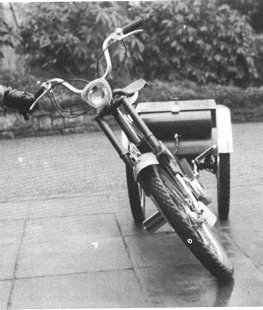
Does it have a slightly familiar look?
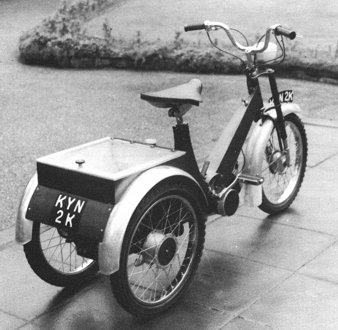
Yes, it looks remarkably similar to our old friend the Ariel Three. Just as his hub steerer had abolished wobble, the three-wheeler was designed to eliminate side-slip. As anyone who has followed an Ariel Three will tell you (it looks worse than it feels to the rider) the Three does not share the hub-steerer's tenacious road holding. However, the principle behind the design was sound and the machine pictured above is a later prototype that developed the idea further.
It was in 1967 that George Wallis's design company - G L Wallis & Son in Surbiton, Surrey - started exploring the idea of designing a safer delivery bicycle. The company was made up of three people: George, his son Tony and Stan Jackson. After three months looking at every possible variation in the design of a bicycle without coming up with any new ideas, George went on holiday to Spain. While he was there he had the idea of making a tricycle that leaned into corners like a tricycle.
Of course, like most ideas, someone had already thought of it before. So, George's first move on return from holiday was to de a patent search. There were three patents dating from the turn of the century: 1897, 1901 and 1905. George, Tony & Stan made models based on the patent specifications and tested them. Their conclusion was that none of the designs worked; the steering geometry made the tricycle very unstable on corners.
They built a new model with variable geometry and experimented with it until a satisfactory set up was found.
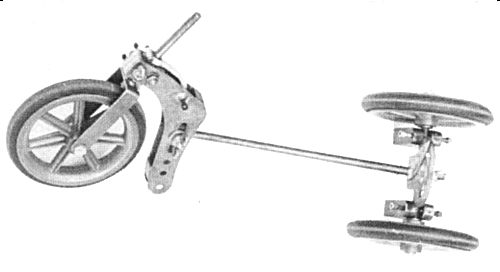
The working model used to test steering geometry
The next step was to build a prototype - this was done and it proved that the system worked.
At this point, BSA enters the story. BSA was looking to enter the moped market, but they wanted something a bit different to any other mopeds. They bought manufacturing rights to the Wallis design and went on to produce the Ariel Three, discussed elsewhere.
Wallis continued to work on the design and built twelve prototype trikes based on the Triumph Tina scooter. These had the Tina's automatic transmission driving the rear wheels via a differential.
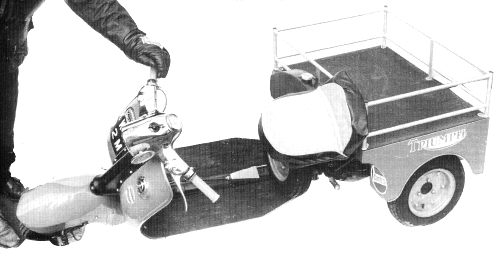
Three-wheeled version of the Triumph Tina
The Tina-based machines went to BSA but, because of its financial problems, BSA was unwilling to do any further development on the design. Under these circumstances, George Wallis's agreement with BSA allowed him to retain the rights to the design and entered negotiation with "a foreign car manufacturer". (The manufacturer's name was not disclosed at the time but it was Daihatsu.) The prototype machine had its engine in the conventional moped position, bigger wheels than the Ariel, and full suspension - telescopic forks at the front and a torsion bar controlled de Dion rear axle. Although fitted with pedals (a legal necessity to qualify as a moped in the UK), the engine had a kick-start. The automatic transmission could vary between 24:1 and 11:1 ratios. Despite all these extra features, it weighed less than the Ariel.
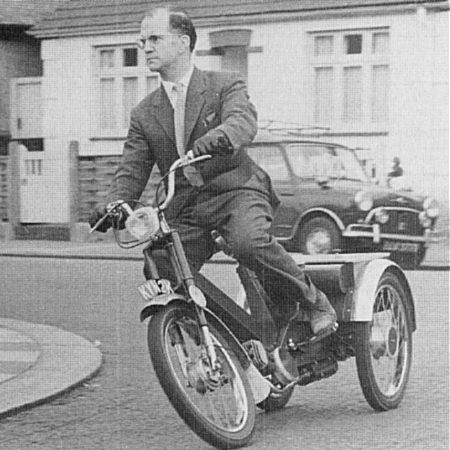
Vic Willoughby trying out a Mark II Wallis prototype
Over in Japan, Daihatsu put the trike into production, making further changes to the design.
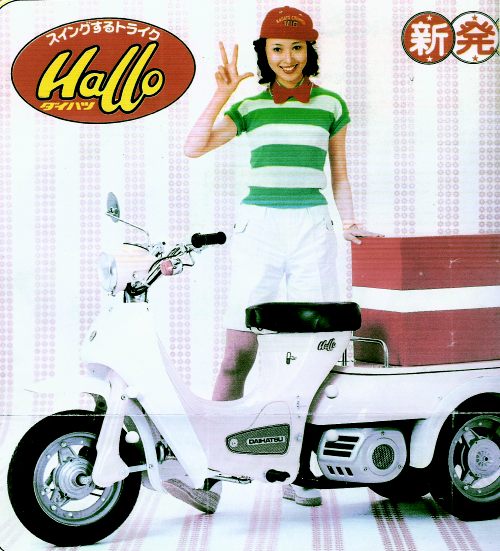
The engine was back on the rear wheel unit, the wheel size was reduced, the pedals dispensed with and leading-link front suspension used instead of the telescopic forks.

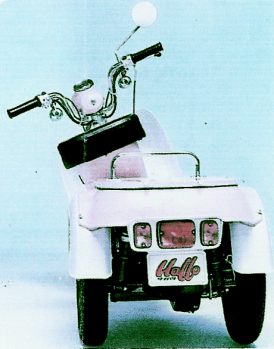
Two views of the Daihatsu Hallo
The Daihatsu Hallo was never sold in the UK, although at least two examples did come here. These were shipped to J J Lee Motorcycles in the hope that they would become the UK agents for the machine. Proprietor, Jim Lee, considered it an excellent machine but the experience of the Ariel Three convinced him that there would not be a market for it.
Daihatsu also produced an electric version of the trike, the ES38V. This had two 12V batteries, whose 75Ah capacity gave it a 30km range at a speed of 30km/h.
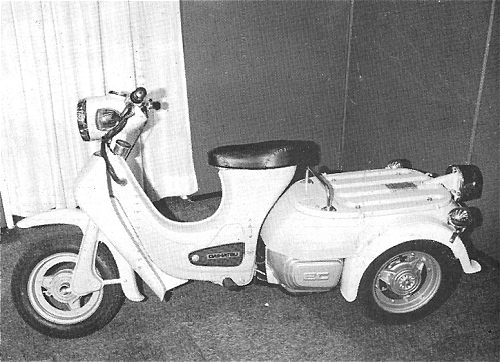
Electric Daihatsu shown at the 1974 Cologne Motor Cycle Show
First published in November 1997, revised & expanded in March 2005